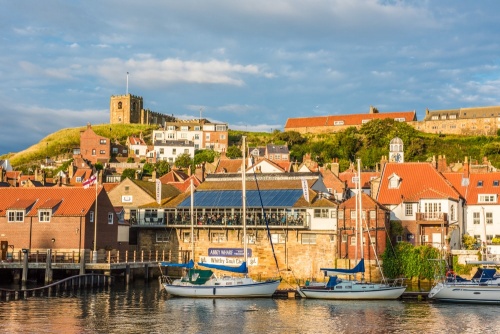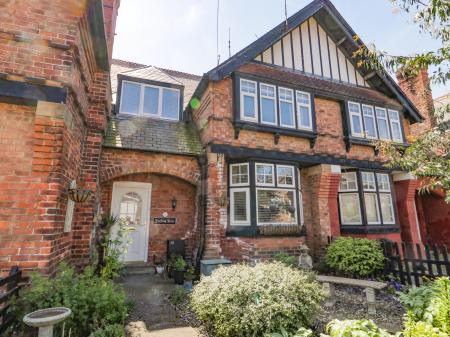
The area was settled as early as the Bronze Age and we know that there was a small community atop the cliffs where Whitby Abbey now stands. At the time the abbey was established the town was known as Streonshalh. When the Vikings destroyed the monastery and sacked the town they renamed the settlement Whitby from the Old Norse meaning 'White Settlement'.
Whitby Abbey
The first abbey atop the cliffs at Whitby was established in the 7th century by a Northumbrian noblewoman named Hild, later sanctified as St Hilda. Hild's abbey was a double-house, with both monks and nuns.
The monastery and its abbess gained such a reputation for scholarship that Whitby was chosen as the site for a famous synod in AD 664 when King Oswiu of Northumbria decided that his kingdom would adopt the Roman rather than the Celtic form of worship. One of the monks under St Hilda's rule was Caedmon, a simple cowherd who would become the first poet in the English language.
The abbey was re-founded on Benedictine lines in 1078 and was dissolved by Henry VIII at the Reformation. The roofless ruins are magnificent, though little remains beyond part of the abbey church. This stands in an exposed clifftop position and boasts a superb rose window piercing the north transept wall.

After the Abbey was suppressed the town remained little more than a fishing port. It was only when alum was discovered nearby in the late 16th century that Whitby became a busy centre for shipping the precious mineral.
With the alum trade, the port grew and Whitby prospered as a merchant shipping centre. Boatyards sprang up, along with rope-making works and sail yards. Whitby's shipyards built some of the 18th century's most famous ships, such as the HMS Bark Endeavour, the Resolution, and the Adventure. Whitby also became a thriving port for the whaling industry.
With the decline of the whaling industry in the 19th century and the arrival of the railway, Whitby began to grow once more, this time as a popular seaside destination. The town grew, not around the old harbour on the east bank of the River Esk, but on the west bank, where a promenade was built, along with luxury hotels to serve the new influx of visitors.
Whitby is really a town of two halves, divided by the River Esk and the harbour. On the east shore of the river is the old half of the town, with winding cobbled lanes and the 199 steep stone steps leading up to the parish church of St Mary and even further to the top of the cliffs where the ruins of Whitby Abbey stand.
It's a delight to wander around the old town, and the combination of the church and abbey makes Whitby a treat for anyone who enjoys heritage sites. Contrast this 'olde worlde' ambience with the Victorian seaside resort atmosphere on the west bank.

St Mary's Church
Below the abbey, accessed by a set of 199 steep steps from the harbour, is the historic church of St Mary. The church served as a place of worship for both monks and townspeople, which explains how it was spared at the Dissolution of the Monasteries.
St Mary's dates to about 1100 AD, but the interior is almost entirely Georgian, with a triple-decker pulpit and 19th-century galleries. There are 18th-century box pews, some inscribed with the curious phrase 'For Strangers Only'.
Captain Cook
Captain James Cook was an apprentice in Whitby, in a 17th-century house in Grape Lane, and it was from Whitby that he set sail on his famous voyage. Cook came to Whitby in 1746 as an apprentice to the Quaker ship owner Captain John Walker. When he was not away at sea, Cook lived in Walker's attic, along with his other apprentices.

The house is now the Captain Cook Memorial Museum and it offers a look at the eventful life and times of Cook and his roots in Whitby. See ship models, personal letters, maps, and objects brought back by Cook from the far-flung lands where he landed on his voyages around the world.
Dracula at Whitby
Bram Stoker was inspired by the ruins of Whitby Abbey to write his classic horror novel, Dracula. There are regular guided walks around the lanes and alleys of Victorian Whitby led by the Whitby Dracula Society 1897. Stoker used the graveyard of St Mary's church as a setting in his novel and described the famous 199 steps up the hillside.
Another literary figure connected with Whitby is Herman Melville, who based several characters in his novel Moby Dick on real-life Whitby whaling captains. Lewis Carroll came to Whitby several times and was inspired to write 'The Walrus and the Carpenter' after a walk along Whitby Beach. A 'White Rabbit Trail' around Whitby follows Carroll's footsteps and visits places that inspired the author.

What else to See
Whitby Museum
The museum holds an astonishing wealth of fossil remains discovered along the coast of east Yorkshire. Among the fossils on display are ammonites, fossilised remains of an extinct marine animal. A local legend says that Whitby was plagued by serpents in the 7th century before St Hilda called upon the power of God and turned the serpents into stone with her staff. The ammonites are said to be the stone remains of the snakes, and indeed, the tight spiral of the fossil shell does resemble coiled snake turned to stone!
Whitby's Whalebone Arch
On West Cliff, overlooking the mouth of the River Esk, is the Whalebone Arch, an archway formed from a set of 20-foot-high whale jaw bones. The arch is a reminder of the role played in Whitby's heritage by the whaling industry in the 18th and 19th centuries.
The original arch was erected in 1853. It was later removed to the Whitby Heritage Centre for preservation and replaced with jaw bones from a 113-ton Fin whale killed by a Norwegian whaling ship in 1963. That replacement was in turn replaced with jawbones from a Bowhead whale killed by Alaskan Inuit in 2003. The arch can be reached by a set of steep steps from the northern end of Pier Road and Khyber Pass road.
Beside the Whalebone Arch stands the iconic bronze statue of Captain Cook, looking over the harbour mouth. The statue was sculpted by John Tweed and erected in 1912. The statue stands 7'6" high and is set atop a high pedestal of freestone. At the base of the pedestal is an inscription reading, 'For the lasting Memory of a great Yorkshire seaman this bronze has been cast, and is left in the keeping of Whitby; the birthplace of those good ships that bore him on his enterprises, brought him to glory, and left him at rest.'

The Swing Bridge
Where the River Esk estuary meets Upper Harbour a historic swing bridge links east and west Whitby. The swing bridge stands on the same site as a 14th-century toll bridge. In 1629 a timber bridge with movable parts was built, though this was later replaced by a drawbridge to let passing ships through.
In 1833 architect Francis Pickernell designed a swing bridge, which has a central pivoting section to allow boats through the water channel. This was rebuilt in 1909 with the present design, with two motorised leaves powered by electric motors.
Whitby Jet
Whitby is famous for 'Whitby Jet', a form of fossilised wood found on the north-east coast of Yorkshire. Jet is found in seams of shale between Boulby in the north and Robin Hoods Bay in the south. The dense fossilised material has such a deep black colour that it gave rise to the expression, 'as black as jet'. It is very lightweight, which means that it can be carved into intricate, highly decorative pieces of jewellery that can be worn comfortably.
Jet rose to prominence in the Victorian period when Queen Victoria wore jet jewellery during her extended period of mourning for Prince Albert's premature death. So popular did jet become that it was the only jewellery allowed to be worn at court.
The first shop dedicated to selling jet jewellery was W Hamond. The shop is still there, at the base of the 199 Steps, and nearby is a heritage centre dedicated to the history of jet and its links to Whitby. Inside the W Hamond shop is the largest piece of jet in the world, an astonishing gemstone stretching 21ft in length.


House Museum










 We've 'tagged' this attraction information to help you find related historic attractions and learn more about major time periods mentioned.
We've 'tagged' this attraction information to help you find related historic attractions and learn more about major time periods mentioned.



